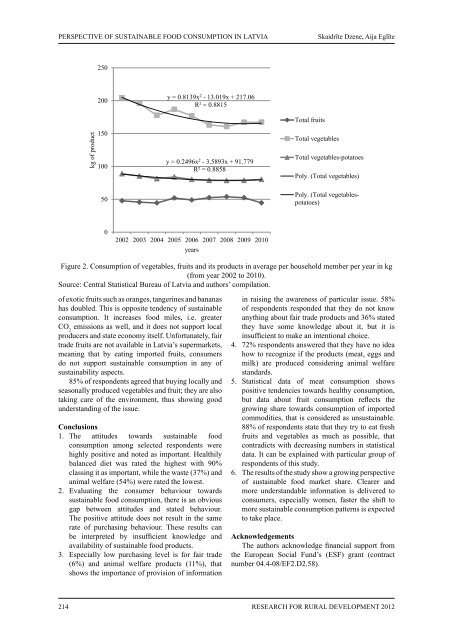RESEARCH FOR
RESEARCH FOR
RESEARCH FOR
You also want an ePaper? Increase the reach of your titles
YUMPU automatically turns print PDFs into web optimized ePapers that Google loves.
0<br />
2002 2003 2004 2005 2006 2007 2008 2009 2010<br />
years<br />
PERSPECTIVE OF SUSTAINABLE FOOD CONSUMPTION IN LATVIA<br />
kg of product<br />
250<br />
200<br />
150<br />
100<br />
50<br />
0<br />
y = 0.8139x 2 - 13.019x + 217.06<br />
R² = 0.8815<br />
y = 0.2496x 2 - 3.5893x + 91.779<br />
R² = 0.8858<br />
2002 2003 2004 2005 2006 2007 2008 2009 2010<br />
years<br />
of exotic fruits such as oranges, tangerines and bananas<br />
has doubled. This is opposite tendency of sustainable<br />
consumption. It increases food miles, i.e. greater<br />
CO 2 emissions as well, and it does not support local<br />
producers and state economy itself. Unfortunately, fair<br />
trade fruits are not available in Latvia’s supermarkets,<br />
meaning that by eating imported fruits, consumers<br />
do not support sustainable consumption in any of<br />
sustainability aspects.<br />
85% of respondents agreed that buying locally and<br />
seasonally produced vegetables and fruit; they are also<br />
taking care of the environment, thus showing good<br />
understanding of the issue.<br />
conclusions<br />
1. The attitudes towards sustainable food<br />
consumption among selected respondents were<br />
highly positive and noted as important. Healthily<br />
balanced diet was rated the highest with 90%<br />
classing it as important, while the waste (37%) and<br />
animal welfare (54%) were rated the lowest.<br />
2. Evaluating the consumer behaviour towards<br />
sustainable food consumption, there is an obvious<br />
gap between attitudes and stated behaviour.<br />
The positive attitude does not result in the same<br />
rate of purchasing behaviour. These results can<br />
be interpreted by insufficient knowledge and<br />
availability of sustainable food products.<br />
3. Especially low purchasing level is for fair trade<br />
(6%) and animal welfare products (11%), that<br />
shows the importance of provision of information<br />
Total fruits<br />
Total vegetables<br />
Skaidrīte Dzene, Aija Eglīte<br />
Total vegetables-potatoes<br />
Poly. (Total vegetables)<br />
Poly. (Total vegetablespotatoes)<br />
Figure 2. Consumption of vegetables, fruits and its products in average per household member per year in kg<br />
(from year 2002 to 2010).<br />
Source: Central Statistical Bureau of Latvia and authors’ compilation.<br />
in raising the awareness of particular issue. 58%<br />
of respondents responded that they do not know<br />
anything about fair trade products and 36% stated<br />
they have some knowledge about it, but it is<br />
insufficient to make an intentional choice.<br />
4. 72% respondents answered that they have no idea<br />
how to recognize if the products (meat, eggs and<br />
milk) are produced considering animal welfare<br />
standards.<br />
5. Statistical data of meat consumption shows<br />
positive tendencies towards healthy consumption,<br />
but data about fruit consumption reflects the<br />
growing share towards consumption of imported<br />
commodities, that is considered as unsustainable.<br />
88% of respondents state that they try to eat fresh<br />
fruits and vegetables as much as possible, that<br />
contradicts with decreasing numbers in statistical<br />
data. It can be explained with particular group of<br />
respondents of this study.<br />
6. The results of the study show a growing perspective<br />
of sustainable food market share. Clearer and<br />
more understandable information is delivered to<br />
consumers, especially women, faster the shift to<br />
more sustainable consumption patterns is expected<br />
to take place.<br />
acknowledgements<br />
The authors acknowledge financial support from<br />
the European Social Fund’s (ESF) grant (contract<br />
number 04.4-08/EF2.D2.58).<br />
214 ReseaRch foR RuRal Development 2012


